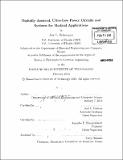| dc.contributor.advisor | Joel L. Dawson and Anantha P. Chandrakasan. | en_US |
| dc.contributor.author | Bohorquez, Jose L | en_US |
| dc.contributor.other | Massachusetts Institute of Technology. Dept. of Electrical Engineering and Computer Science. | en_US |
| dc.date.accessioned | 2010-09-01T16:25:02Z | |
| dc.date.available | 2010-09-01T16:25:02Z | |
| dc.date.copyright | 2010 | en_US |
| dc.date.issued | 2010 | en_US |
| dc.identifier.uri | http://hdl.handle.net/1721.1/58074 | |
| dc.description | Thesis (Ph. D.)--Massachusetts Institute of Technology, Dept. of Electrical Engineering and Computer Science, 2010. | en_US |
| dc.description | Cataloged from PDF version of thesis. | en_US |
| dc.description | Includes bibliographical references (p. 219-225). | en_US |
| dc.description.abstract | In recent years, trends in the medical industry have created a growing demand for a variety of implantable medical devices. At the same time, advances in integrated circuits techniques, particularly in CMOS, have opened possibilities for advanced implantable systems that are very small and consume minimal energy. Minimizing the volume of medical implants is important as it allows for less invasive procedures and greater comfort to patients. Minimizing energy consumption is imperative as batteries must last at least a decade without replacement. Two primary functions that consume energy in medical implants are sensor interfaces that collect information from biomedical signals, and radios that allow the implant to communicate with a base-station outside of the body. The general focus of this work was the development of circuits and systems that minimize the size and energy required to carry out these two functions. The first part of this work focuses on laying down the theoretical framework for an ultra-low power radio, including advances to the literature in the area of super-regeneration. The second part includes the design of a transceiver optimized for medical implants, and its implementation in a CMOS process. The final part describes the design of a sensor interface that leverages novel analog and digital techniques to reduce the system's size and improve its functionality. This final part was developed in conjunction with Marcus Yip. | en_US |
| dc.description.statementofresponsibility | by Jose L. Bohorquez. | en_US |
| dc.format.extent | 225 p. | en_US |
| dc.language.iso | eng | en_US |
| dc.publisher | Massachusetts Institute of Technology | en_US |
| dc.rights | M.I.T. theses are protected by
copyright. They may be viewed from this source for any purpose, but
reproduction or distribution in any format is prohibited without written
permission. See provided URL for inquiries about permission. | en_US |
| dc.rights.uri | http://dspace.mit.edu/handle/1721.1/7582 | en_US |
| dc.subject | Electrical Engineering and Computer Science. | en_US |
| dc.title | Digitally-assisted, ultra-low power circuits and systems for medical applications | en_US |
| dc.type | Thesis | en_US |
| dc.description.degree | Ph.D. | en_US |
| dc.contributor.department | Massachusetts Institute of Technology. Department of Electrical Engineering and Computer Science | |
| dc.identifier.oclc | 631100628 | en_US |
